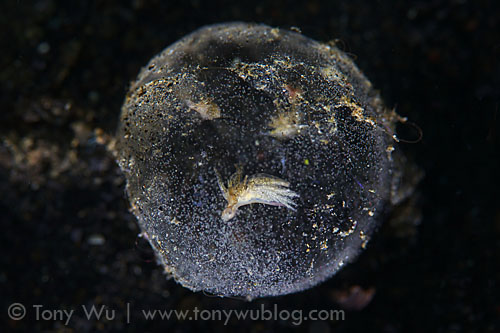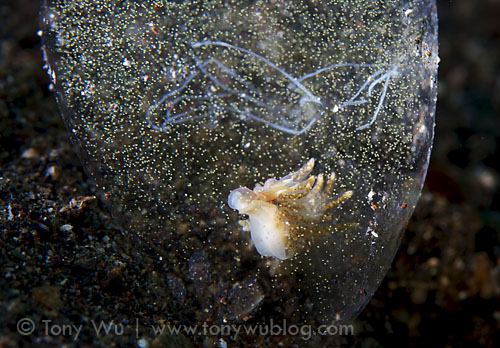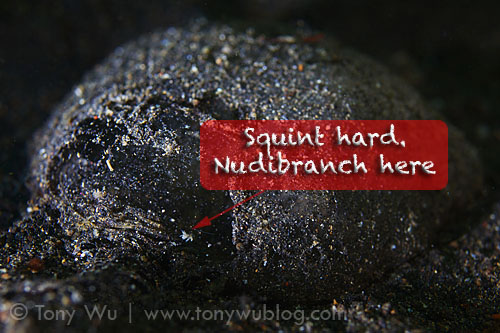Have you ever noticed delicate bubble-like things clinging to the bottom of reef and muck sites, usually swaying with the current and looking like not much of anything?
I must've swum past hundreds, if not thousands of these...all the time wondering what they were. I confess to having poked a few every now and then to see if anything interesting might happen, but nothing ever did...until Lembeh last month.
After so many years of seeing so many bubbles doing so much of nothing, I saw dozens of these bubbles with what appeared to be aeolid nudibranchs inside them.

In the photo above, you can see at least three nudibranchs inside the bubble, one in the foreground and two behind.
At first, I was just surprised to find something inside one of these bubbles. After looking around a bit and finding many more bubbles with sea slugs inside, I started wondering what the nudibranchs were doing.
We came up with all sorts of theories...ranging from "laying eggs" to "eating the bubbles" and everything in between.
As it turned out, Mean was able to find a reference online, which seems to have solved the mystery. According to well-known nudibranch authority Bill Rudman, the aeolid nudibranchs appear to be feeding on the eggs of some sort of polychaete worm. Bill has tentatively identified the nudibranchs as Favorinus sp.
One of the things that confused me at first was that some of the nudibranchs appeared to be laying eggs, as you can see in this photo:

I think the white stringy stuff above the nudibranch are eggs that the nudibranch laid (I have other photos that seem to show a trail of eggs coming out of the nudibranch).
It seems that the nudibranchs, in some instances at least, might be laying eggs of their own as well as eating those that make up the bubbles they're feeding on. Cool, huh?
Even more intriguing...some of the nudibranchs I came across were really, really small...begging the question of whether they had perhaps recently hatched and subsequently consumed the eggs inside their host bubbles.

Going through the process of observing the nudibranchs, coming up with theories about what the opistobranchs were doing, and then confirming our theories online was an incredibly interesting and satisfying process.
But what's bothering me now is why...after all these years of looking and seeing nothing...we suddenly saw so many of these nudibranchs-in-bubbles over the course of a few days.